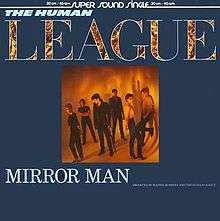Mirror Man (The Human League song)
"Mirror Man" is a 1982 song by the British synthpop group The Human League. It was released as a single in the UK on 8 November 1982 and peaked at number two in the UK Singles Chart. It was written jointly by lead singer Philip Oakey with keyboard players Jo Callis and Ian Burden, and produced by Martin Rushent.
| "Mirror Man" | ||||
|---|---|---|---|---|
 | ||||
| Single by The Human League | ||||
| from the album Fascination! | ||||
| B-side | "You Remind Me Of Gold" | |||
| Released | 8 November 1982 | |||
| Recorded | Genetic Studios, Reading, England | |||
| Genre | Synthpop, new wave | |||
| Length | 3:52 | |||
| Label | Virgin, A&M | |||
| Songwriter(s) | Philip Oakey, Jo Callis, Ian Burden | |||
| Producer(s) | Martin Rushent | |||
| The Human League singles chronology | ||||
| ||||
Background
"Mirror Man" was the first track written and recorded by the Human League after they returned from their World Tour, conducted in the wake of the enormous international success of their album Dare. "Mirror Man" was conceived and written as a celebration of Oakey and Wright's love of Motown records. It has been described as electronic northern soul, with Oakey's main verses delivered in deliberate sentences with emphasis on the last word of each sentence. Vocalists Susan Ann Sulley and Joanne Catherall feature prominently throughout the song but have no lyrics, providing backing vocals of "oohs" and "ahhs". Recording and production was overseen by Martin Rushent, who had produced the band's album Dare.
Speculation about who was the titular 'Mirror Man' was ended in 1988 when, during interviews to promote the band's Greatest Hits album, Oakey revealed that it was about Adam Ant. Oakey had become concerned that Ant was starting to believe his own publicity, and was in danger of losing touch with reality. Oakey had avoided revealing this at the time for fear of offending the song's subject.
The song was released as a single in the UK in November 1982. It was the first new single the band had released since the phenomenal success of "Don't You Want Me" almost a year earlier. The single was tipped by the media as their second Christmas number-one single in the UK, but peaked just short, at number two.[1] The single did however reach number one in Ireland earlier that month and also reached the Top 10 in Canada the following February.
Its release in the U.S. was delayed until May 1983 where it was incorporated into the stop gap EP Fascination!. A&M Records, the band's record company in the US, had refused to release it as a single "unless there was to be an album hot on its heels".[2] The track peaked at number 30 on the Billboard Hot 100 in the fall of 1983.
Promotional video
The promotional video for "Mirror Man" was conceived and directed by Duffy[3] and was filmed on location at a deserted theatre in London. The basic premise is that Oakey is a ghost of a performer who has died and now inhabits the theatre where he reveals himself to the band who have come to rehearse. The main scenes are of Oakey in a dressing room singing to a mirror, spliced in with footage of the crash and death of John Cobb (whilst attempting to break the world water speed record on Loch Ness on 29 September 1952).
Chart performance
| Chart (1982-1983) | Peak position |
|---|---|
| Australia (Kent Music Report)[4] | 4 |
| Belgium Singles Chart (Vl) | 17 |
| Canadian RPM 50 Singles | 7 |
| Dutch Singles Chart | 31 |
| French Singles Chart[5] | 84 |
| Irish Singles Chart | 1 |
| New Zealand Singles Chart | 23 |
| Spain (AFYVE)[6] | 10 |
| Swedish Singles Chart | 19 |
| UK Singles Chart | 2 |
| US Billboard Hot 100 | 30 |
References
- "Artist Chart History - The Human League". Official Charts Company. Retrieved 22 June 2013.
- "Sounds 12th August 1978 THE HUMAN LEAGUE". The-black-hit-of-space.dk. Retrieved 5 November 2016.
- Human League Greatest Hits Video, 1988, credits
- Kent, David (1993). Australian Chart Book 1970–1992. St Ives, NSW: Australian Chart Book. ISBN 0-646-11917-6.
- "Archived copy". Archived from the original on 20 September 2013. Retrieved 2012-06-23.CS1 maint: archived copy as title (link)
- Salaverri, Fernando (September 2005). Sólo éxitos: año a año, 1959–2002 (in Spanish) (1st ed.). Spain: Fundación Autor-SGAE. ISBN 84-8048-639-2.